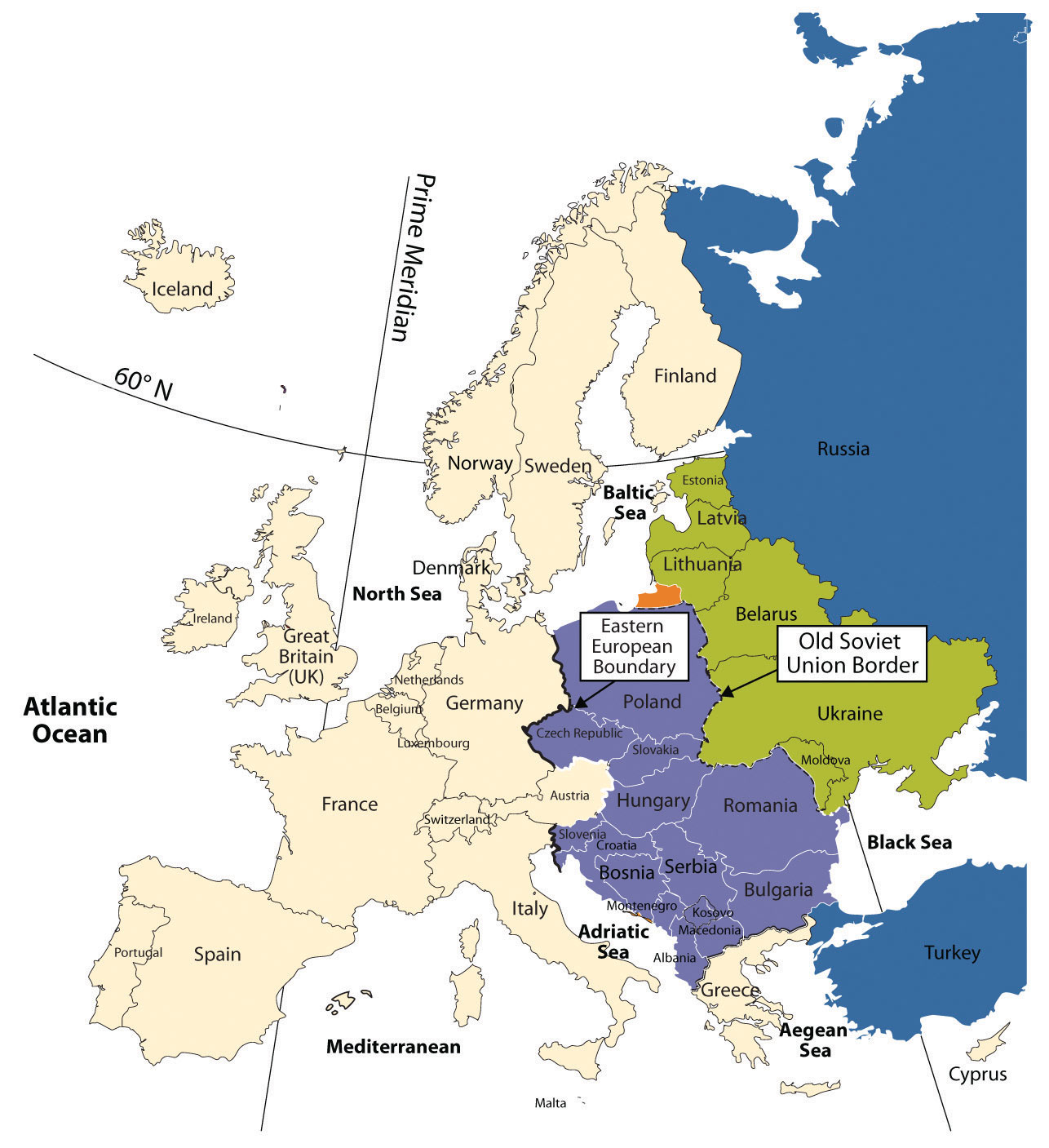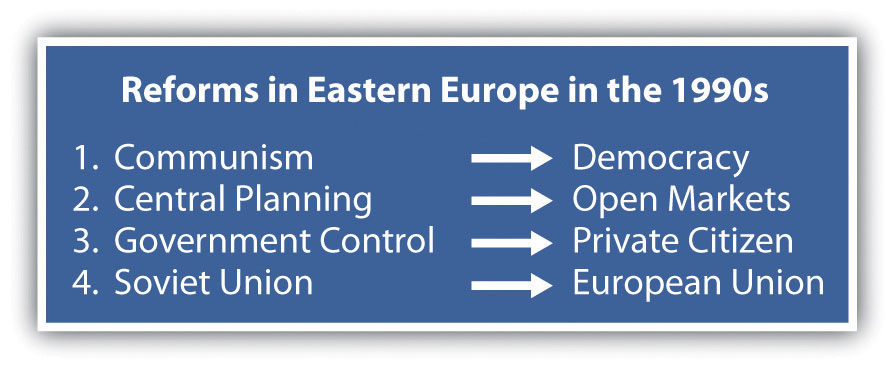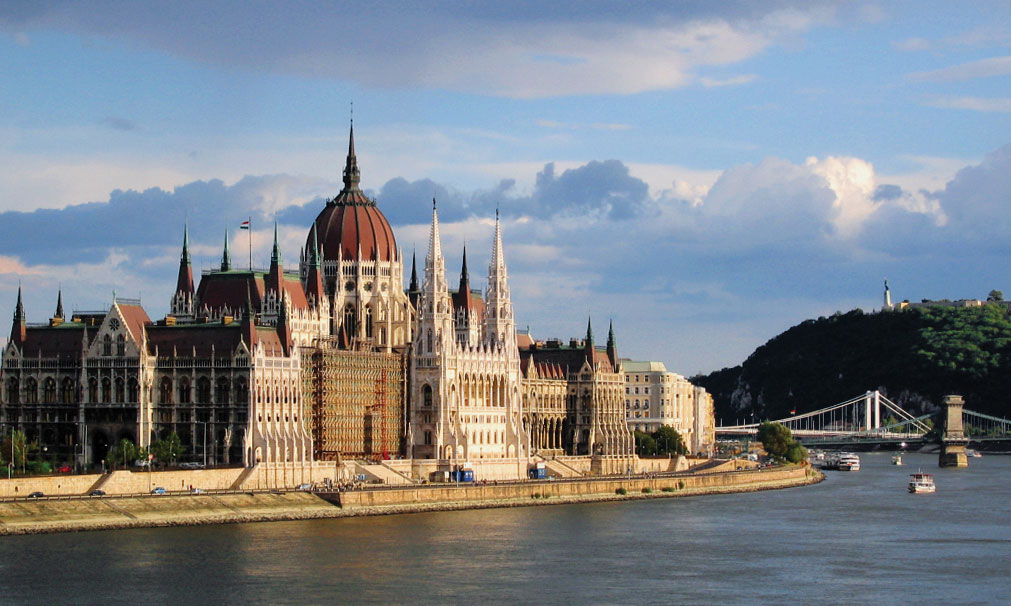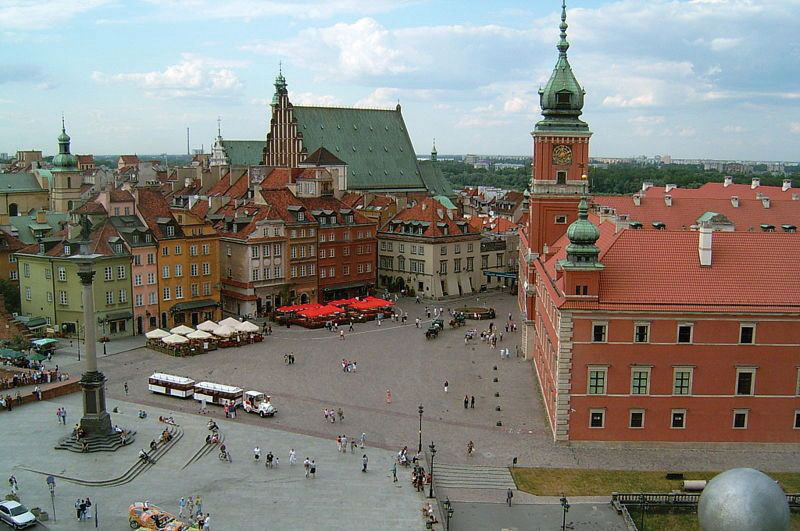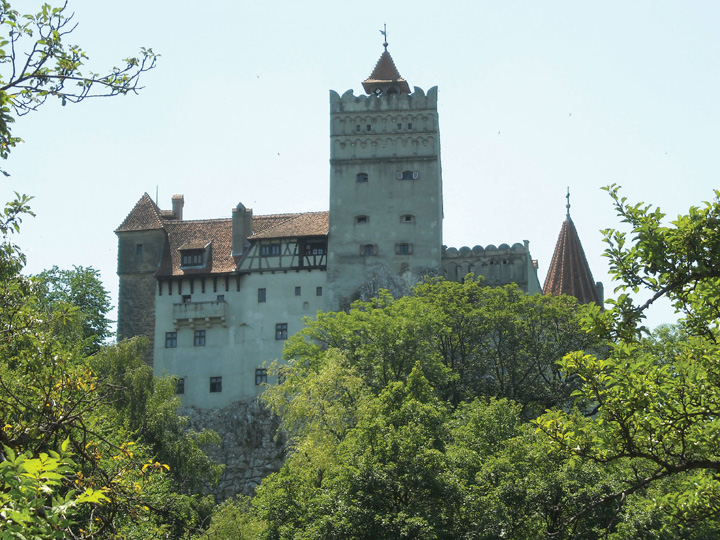2.4 Eastern Europe
Learning Objectives
- Explain how Eastern Europe and Western Europe were divided and how they united again.
- Describe the various aspects of transition from socialism systems to capitalist democracies.
- Outline which countries were former republics of the Soviet Union but are now a part of Eastern Europe. Define the current borders of the Eastern European countries.
- Describe some of the cultural dynamics that make each region or country unique.
- Summarize the basic economic activities that are evident in the various countries and how they have transitioned into a postindustrial economy.
- Understand the cultural and political geography of former Yugoslavia and how the drive for nationalism and nation-state status has fractured and divided the region.
Transitions of Eastern Europe after the Cold War
After World War II ended in 1945, Europe was divided into Western Europe and Eastern Europe by the Iron Curtain. Eastern Europe fell under the influence of the Soviet Union, and the region was separated from the West. When the Soviet Union collapsed in 1991, all the Soviet Republics bordering Eastern Europe declared independence from Russia and united with the rest of Europe. The transition Eastern Europe has experienced in the last few decades has not been easy; however, most of the countries are now looking to Western Europe for trade and economic development. Cooperation continues between Eastern and Western Europe, and the European Union (EU) has emerged as the primary economic and political entity of Europe.
The collapse of Communism and the Soviet Union led to upheaval and transition in the region of Eastern Europe in the 1990s. Each country in the region was under Communist rule. The countries bordering Russia were once part of the Soviet Union, and those countries not part of the Soviet Union were heavily influenced by its dominant position in the region. When the Soviet Union collapsed in 1991, the bordering countries declared independence and began the process of integration into the European community. Moldavia changed its name to Moldova. The countries of Czechoslovakia and Yugoslavia each broke into multiple countries and, because of the diverse ethnic populations, organized around the concept of nation-states. (See Section 2.2.6 “Nation-States and Devolution” for a discussion of nation-states.) Czechoslovakia peacefully agreed to separate into two states: the Czech Republic and the Republic of Slovakia. Yugoslavia was not so fortunate, and saw extensive conflict and bloodshed in the 1990s as the country split apart.
Most Eastern European political borders resemble ethnic boundaries. Each of the regions once resembled nationstates. In principle, Romania is set apart for Romanians, Hungary for Hungarians, and so on. Few are true nationstates because of ethnic minorities located within their borders, but the countries held on to their common heritage throughout the Communist era. In most Eastern European countries, cultural forces have brought people together to publicly support the move to unite and hold onto a heritage that is as old as Europe itself.
Governments that had been controlled by Communist dictators or authoritarian leadership before 1991 were opened up to democratic processes with public elections. With the fall of Communism came economic reforms that shifted countries from central planning to open markets. Under central planning, the governments dictated which products were produced and how much of each were produced. The open markets invited private capitalism and western corporate businesses.
The power of the state was transferred from the Communist elite to the private citizen. People could vote for their public officials and could choose businesses and work individually. With the EU looming over the realm, the now independent countries of Eastern Europe shifted their economic direction away from Moscow and the collapsing communist state and toward the core industrial countries of Western Europe and the EU.
The stage for the transition from communism to capitalism was further set by Soviet leader Mikhail Gorbachev in the late 1980s, who began to liberalize the Soviet Union by allowing multiparty elections and encouraging economic reform and societal openness (concepts known throughout the world by the Russian words perestroika and glasnost, respectively). At the same time, the world watched as the communist Chinese government violently cracked down on student protests in the Tiananmen Square protests of 1989, which strengthened the revolutionary sentiments and intentions of many people in the Eastern bloc, the former Communist countries of Eastern Europe.
Countries of Eastern Europe
Hungary
During the Communist period, Hungary enjoyed a higher standard of living than its neighbors. Economic reforms following the fall of communism have not been easy for Hungary and have resulted in a lower standard of living for most people. The removal of government subsidies, a pillar of Communist rule, led to recession. To avoid massive inflation and attract investment, government fiscal policies had to be conservative to the point of austerity. Hungary’s large scale manufacturing and stable government have aided it through the latest global economic downturn.
An important characteristic of post-Communist Hungary is its desire to become an active member of the global community by joining international organizations. In 1990, Hungary was the first Eastern bloc nation to join the Council of Europe. In 2004, Hungary joined the EU. In addition, Hungary joined the other international organizations, including the Organisation for Economic Co-operation and Development (OECD), the International Monetary Fund (IMF), and the World Trade Organization (WTO). Another endeavor that would not have been possible under the Communist rule was the development of tourism as an important economic sector. Budapest’s reputation as a city of great elegance has helped it become one of the major tourist attractions in Eastern Europe. Major movie studios have also traveled to the city to film.
Figure 2.31 Parliament Building in Budapest, Hungary, Next to the Danube River
Wikimedia Commons – CC BY 2.0.
The Czech Republic and the Slovak Republic (Slovakia)
Each country in Eastern Europe has a different story to tell regarding its path from communism to independence. Countries such as the Czech Republic and Hungary were more prepared and better equipped to meet the challenges and were early qualifiers for entry into the EU. Historically, the region occupied by the modern Czech Republic was known as Bohemia and Moravia. The Czech Republic and Slovakia were, until recently, part of the same country: Czechoslovakia, which was created in 1918 from part of the Austro-Hungarian Empire after World War I ended. On January 1, 1993, they became two new independent nations. Slovakia is known officially as the Slovak Republic.
Czechs and Slovaks alike descended from Slavic peoples. The national language of the Czech Republic is Czech, while the official language of Slovakia is Slovakian. Both languages are in the Slavic linguistic family. About 94 percent of the population of the Czech Republic identify themselves as ethnically Czech. The others are Slovenian, Polish, German, Hungarian, and Roma (Gypsy). About 86 percent of the inhabitants of Slovakia self-identify as ethnically Slovakian. Hungarians make up the largest minority population, and about 2 percent of the population identify themselves as Roma.
Under Communist rule, the standard of living was very high in Czechoslovakia. When market reforms began in the Czech Republic and Slovakia, the standard of living declined to some extent. In general, the Czech Republic has more rapidly and effectively transferred state control of industry to private ownership than has Slovakia. Also, Slovakia was hit harder by the move away from defense industries, which had employed many people during the Communist period. Unemployment has consistently been higher in Slovakia. Slovakia is not as industrialized as the Czech Republic but has made strides since independence to provide economic opportunities for its people. Both countries expanded their economic opportunities when they were admitted into the EU in 2004.
The Baltic Republics
The small Baltic states of Latvia, Estonia and Lithuania transitioned away from their old Soviet connections. After independence, they were quick to look toward Western Europe for trade and development. Most Eastern European countries followed this pattern. Latvia, Estonia, and Lithuania received their independence from the Soviet Union in 1991. Russia withdrew its troops from the region in 1994. The North Atlantic Treaty Organization (NATO) and the EU welcomed them as members in 2004. They have transitioned to market economies with democratic governments. The people of Latvia, Estonia, and Lithuania rapidly expanded their economic conditions after independence but have been hard hit by the downturn in the global marketplace in 2008.
Poland
Poland has a long-standing history of working to oppose the Communist domination of its country. The Sbolidarity movement in Poland started out as an independent trade union in the 1980s but became a lightning rod for political change in Poland. Also, Poles found inspiration in the 1978 election of the very anti-communist Pope John Paul II, the first Polish leader of the Catholic Church. The Communist Party dominated politics and suppressed any movement to organize labor or the people against the government. The strength of Solidarity became evident by the 1990 election, when Solidarity candidate Lech Wałęsa won Poland’s presidential election. Solidarity’s victory signified the collapse of the power of the Soviet Union and communism in Eastern Europe. The country has emerged with democratic government and a thriving capitalist economy.
Since the fall of communism, Poland left behind its old state-directed economy and transitioned to a market economy, in which businesses are privately owned and run. When the communists controlled Poland, there was a strong emphasis on heavy industry, and that focus remains alive today. Poland produces cars, buses, helicopters, trains, and heavy military equipment, including tanks and ships. Before the communists industrialized the Polish economy, it was largely agrarian. Though Poland continues to be one of Europe’s leading agricultural producers, with a wide variety of crops and dairy and meat production, it is unable to meet the food demands of its large population. Poland’s economy is still considered to be under development. Reforms, including privatization, must continue before Poland can adopt the euro, the common EU currency.
Figure 2.25 Royal Castle Square in Warsaw, Poland
Unemployment has at times presented very significant problems for the Polish economy and society. Unemployment skyrocketed to nearly 20 percent in the early 1990s. The situation improved, but unemployment was still at about 14 percent in 2006. By 2010 the situation improved further, and the unemployment rate was around 7 percent. When Poland joined the EU, many people left Poland in search of work. Some of those workers who left have recently returned, as the employment rate and wages are both increasing substantially.
Moldova
A variety of cultural and social forces provided different levels of civility in the transitions of Eastern Europe. The poor, agrarian economy of the small, landlocked country of Moldova provides few opportunities or advantages to grow its economy and provide a stronger future for its people. As a result, young people earning an education or technical skills immigrate to other countries for opportunities or employment.
Belarus
In 1991, independence came to the former Soviet Republic of Belarus, but Belarus took a different path from most of the other Eastern bloc countries in that Belarus did not distance itself from its Russian connection. Belarus has consequently experienced authoritarian governments well into the twenty-first century. In this case, Russia and Belarus created a stronger relationship by signing agreements to increase economic integration. Difficulties have hindered implementation of many of these policies. For one thing, the government of Belarus has been slow to move toward democratic reforms. In fact, the president has taken on greater authoritarian powers. Some of the personal freedoms that have been granted in other European countries—freedom of the press, free speech, and the right to peacefully assemble—are still restricted in Belarus. As of 2010, Belarus, Ukraine, and Moldova have not been admitted into the EU. Belarus has indicated that it might join with the Russian Republic and has not even applied for entry into the EU. Belarus is a member of The EU Eastern Partnership (EaP) a joint initiative involving the EU, its Member States and six Eastern European Partner countries: Armenia, Azerbaijan, Belarus, Georgia, the Republic of Moldova and Ukraine. Belarus-EU relationships began to worsen after the election of Alexander Lukashenko in 1994.
Ukraine
With the largest physical area in Europe, Ukraine is slightly larger than France. Its population in 2010 was approximately forty-six million, and 77 percent of the population is ethnically Ukrainian and 17 percent is Russian. Most of the population live in the industrial regions of the southeast or eastern parts of the country. Though the official language is Ukrainian, many Ukrainians still speak Russian. As is the case with neighboring states, the Eastern Orthodox Church dominates the religious and cultural reflections of the arts, literature, and architecture. Christian themes are often reflected in the paintings, books and performances.
The demographic trend in Ukraine follows a pattern of industrialization with smaller family sizes but continues to have a higher death rate than most European countries. The country is now losing about 150,000 people per year. The low birth rates are similar to those of Russia and southern Europe. Poor health and childhood poverty in Ukraine are two of the main issues confirmed by the United Nations (UN). In 2010, Ukraine had a negative population growth rate of −0.62 percent. Fertility rates have been in decline throughout Europe over the past few decades. The average fertility rate in Ukraine is 1.1, one of the world’s lowest; in Europe as a whole, the average is about 1.3. The causes for some of these trends can be attributed to alcoholism, poor diets, smoking, and the lack of medical care. The average life expectancy for an adult male in Ukraine is about sixty-two years. In comparison, the average life expectancy for men in France is about seventy-eight years.
Of the former Soviet Union republics, excluding Russia, Ukraine was far and away the most important economically, producing about four times the output of the next-ranking Soviet republic. Its fertile black soil generated more than one-fourth of the overall Soviet agricultural output, and its farms provided substantial quantities of meat, milk, grain, and vegetables for other republics. Likewise, its diversified heavy industry supplied steel pipes and raw materials to Russia’s oil and mining industry. Ukraine’s political relationship with Russia has been complicated since the dissolution of the Soviet Union, but Russia still supplies enormous amounts of natural gas and oil to fuel the economy, and Russia’s markets are still highly integrated with those of Ukraine.
Though Ukraine has transitioned from a Soviet republic to a fully independent country, divisive centrifugal forces have made Ukraine’s path to free elections and democratically elected leaders difficult. Today, the country has a democratically elected government and is working toward improving its economy and creating stability for its people. Russia has long viewed Ukraine as part of itself, and in 2014 invaded and annexed the region of Crimea on the Black Sea. It then staged a massive assault on the entirety of Ukraine in early 2022, which failed to take the capital city of Kiev, and has been largely rebuffed but is ongoing.
Romania
A number of countries of Eastern Europe have fully transitioned from Communist dictatorships to modern, integrated economies. Romania is one of those countries. Romania encompasses an area equivalent to the US state of Minnesota. Its population of 21.5 million people includes two million who live in Bucharest, the capital and largest city of the country. The Carpathian Mountains circle Romania, with the Transylvanian Alps to the south. The Danube River runs across the region and creates a natural border with Bulgaria and Serbia before flowing into the Black Sea. The Romanian forests are some of the largest in Europe, with about half (13 percent of the country) set aside from logging and placed in watershed conservation programs. The integrity of the ecosystems in the Romanian forests provide diverse habitats for plants and animals. Romania claims to have the most European brown bears and about 40 percent of all European wolves living within its borders.
Tourism is growing in Romania. Almost 5 percent of Romania is placed in protected areas, including thirteen national parks and three biosphere reserves, all of which are attractive to tourists. Tourist attractions also include medieval castles as well as historic Transylvanian cities. Rural tourism focuses on folklore and traditions including such sites as Bran Castle, referred to locally as the castle of Dracula, a mythical person patterned after the stories and legends of Vlad III the Impaler.
Romania’s Communist dictator, Nicolae Ceauşescu, ruled from 1965 to 1989. The end of his domination came when the government was overthrown by a revolution. Ceauşescu and his wife were arrested and shot to death. Even after his death, the Communist Party maintained strong ties to the government until the mid-1990s.
The transition to integrate Romania’s economy with that of the greater European economy was delayed because of Romania’s obsolete industrial infrastructure, established during the Communist era. Since joining the EU in 2007, Romania has developed a stronger export market with Western European countries. Investments and consumer confidence have fueled the growth of the domestic economy. Romania has worked through a number of difficult issues in its attempts to provide a stable government and a growing market economy.
Albania
The southern Adriatic is home to the small country of Albania. The rugged mountainous country of Albania has a Muslim majority. Poverty, unemployment, and a lack of opportunities to gain wealth have plagued the country.
Albania has even received Communist support from China. As a result of the war in Kosovo (see below), Albania suffered a major setback in its progress toward an improved standard of living and integration with the rest of Europe. When stability is established, Albania can progress toward becoming more integrated with the European economy and raise its standard of living for its people. A parliamentary democracy has been installed since the Communist era, and foreign investments have aided in developing updated transportation and power grids.
Bulgaria
Located in the crossroads of the continents, Bulgaria has a major trans-European corridor running through its territory that connects all the way to Asia. The country is home to diverse landscapes, which include the sunny Black Sea coast and the higher elevations of the Balkan Mountains, which reach an elevation of 9,596 feet. The Danube River flows across the border with Bulgaria on its way to the Black Sea. About one-third of the country consists of plains, which provide for extensive agricultural activity. Ore and minerals can also be found in Albania, which has allowed the country to gain wealth.
Upon declaring independence from Russia, Bulgaria held multiparty elections. Its economy is emerging, but the transition to a capitalist system has not been without the difficulties of unemployment, inflation, and corruption. Bulgaria became a member of NATO in 2004 and was accepted for EU membership in 2007. The transition to a free market economy is still in progress, with mining, industry, and agriculture as the main economic activities. Tourism is an emerging segment of the economy that has been gaining international attention in recent years. The country has a milder climate than the northern states of Eastern Europe and has been marketing itself as a major tourist destination. Main points of interest include historical monasteries, coastal resorts on the Black Sea, and the capital city of Sofia.
Former Yugoslavia
The name Yugoslavia, applied to the region along the Adriatic in 1929, means Land of the South Slavs. Non-Slavic populations surround Yugoslavia. The region’s core is mountainous. The Dinaric Alps, with the highest peak at just below nine thousand feet in elevation, run through the center of the Balkan Peninsula. The rugged mountains separate and isolate groups of Slavic people who, over time, have formed separate identities and consider themselves different from those on the other sides of the mountain ridges. Distinct subethnic divisions developed into the Slovenes, Macedonians, Bosnians, Montenegrins, Croats, and Serbs, with various additional groups. These differences led to conflict, division, and war when the breakup of former Yugoslavia began.
World War I started in the city of Sarajevo, Bosnia, when a Serb advocate assassinated Archduke Ferdinand of the Austria-Hungarian Empire. In the next conflict, World War II, there was also divisiveness within Yugoslavia: Croatia sided with Nazi Germany, but Serbia allied with the Communist Soviet Union. The region of Bosnia, with a Muslim majority, faced religious opposition from its mainly Christian neighbors. A group headed by Marshal Tito (a.k.a. Josip Broz) led Yugoslavia after World War II ended in 1945. Tito created a Communist state that attempted to retain its own brand of neutrality between the Warsaw Pact nations led by the Soviet Union and the NATO nations of the West.
Tito was a centripetal force for the region of Yugoslavia. For over forty years, he held the many ethnic Slavic groups together under what he called Brotherhood and Unity, which was actually the threat of brute military force. It appears to have been effective. The 1984 Winter Olympics were held in Sarajevo as witness to the progress and unity of Tito’s Yugoslavia. At the same time, Yugoslavia started manufacturing a model of automobiles called the Yugo. While the Yugo was not in the same league as high-end European luxury cars, the ability to make and purchase automobiles was a testimony to the rising industrial level of the Yugoslav economy. This progressive trend, unfortunately, was not to last.
Figure 2.34 The Balkan Peninsula and Former Yugoslavia
Macedonia is officially called the Former Yugoslav Republic of Macedonia (FYROM) because of a name conflict with Greece. Albania is an independent country and was never a part of Yugoslavia.
The Breakup of Former Yugoslavia
Tito died in 1980. The unity that had helped hold the country together began to break down in the early 1990s with the Soviet Union’s collapse. With the dual loss of the Soviet Union and Tito’s strong policies as centripetal forces, the power struggle for dominance among the various ethnic groups began.
In 1991, Slobodan Miloševic began pushing for the nationalistic goal of uniting all the ethnic Serbs that lived in the various parts of Yugoslavia into a Greater Serbia. The situation deteriorated to the point of ethnic cleansing (genocide). A long conflict with extensive bloodshed and intervention by Western peace-keeping forces ensued, and made focal areas of the conflict such as Bosnia and Kosovo everyday words in America. This situation has evolved, and today a number of independent nation states have descended from the former Yugoslavia. Bosnia today is the most diverse of these, with a majority Muslim population. Miloševic was arrested for war crimes and died awaiting trial. Today the region has calmed and its image has softened; for instance, it today is attracting increasing numbers of tourists to its beautiful Adriatic shoreline and mountains.
Former Yugoslavia represents an example of how divisive centrifugal and devolutionary forces can lead to nationalism and eventually to war. The drive toward a nation-state has fueled nationalism and conflict in the Balkans. The civil wars within former Yugoslavia have cost thousands of lives and destroyed an infrastructure that had taken decades to build. Geographers have called Eastern Europe a shatterbelt because of the conflicts and divisions that have occurred there.
In spite of the problems with the transition in Eastern Europe, the region has nonetheless seen enormous economic gains. Even Slovenia, once part of former Yugoslavia, has rebounded with strong economic growth. Many of the progressive Eastern European countries have been accepted into the EU. The map of the EU includes many of the developing Eastern bloc countries. Eastern Europe has experienced many transitions throughout its history. The transition from communism to capitalism is only one part of the geography and history of Eastern Europe.
Key Takeaways
- After World War II ended in 1945, Europe was divided into Western Europe and Eastern Europe by the Iron Curtain. Western Europe promoted capitalist democracies, and Eastern Europe came under the Communist influence of the Soviet Union. After the collapse of the Soviet Union in 1991, Eastern Europe began to transition toward Western European ideals.
- Eastern Europe has been shifting toward democratic governments, open market economies, private ownership, and the EU rather than the old Soviet Union.
- Countries with stable governments and industrial potential have been accepted into the EU and have expanding economies. Other countries that have not reached that level of economic development or political reforms have not been admitted into the EU.
- The transition of former Soviet republics to capitalist systems has not been without difficulties, including unemployment, inflation, corruption and crime, and poverty. Political infighting has been evident in the transitioning countries that do not yet have a stable democratic government or economy.
- The breakup of former Yugoslavia was an example of how strong devolutionary forces can promote nationalism resulting in open war. The once stable country of Yugoslavia split into seven separate countries patterned after the nation-state concept. Bosnia remains the most diverse state, with a majority Muslim population.
Discussion and Study Questions
- What were four of the main reforms that occurred in Eastern Europe with the collapse of the Soviet Union?
- Which Eastern European countries were once members of the Soviet Union?
- What factor has most heavily influenced most of the political boundaries of Eastern Europe?
- How would the change from central planning to open markets influence the use of natural resources?
- Which countries of Eastern Europe are members of the EU?
- How did the larger Slavic population of former Yugoslavia five hundred years ago become the existing subgroups of the Slovenes, Croats, Bosnians, Montenegrins, and Serbs?
- Why was Slobodan Miloševik so determined to keep the region of Kosovo under Serb control?
- What was the purpose of ethnic cleansing in former Yugoslavia?
- What role did religion play in the wars in Bosnia and Kosovo?
- Why would the United States be so concerned about the wars in Bosnia and Kosovo—so much so that the United States spent billions to help end the war and then billions more to keep the peace and rebuild the region?
Geography Exercise
Identify the following key places on a map:
- Adriatic Sea
- Albania
- Baltic Sea
- Belarus
- Black Sea
- Bosnia
- Croatia
- Czech Republic
- Estonia
- Hungary
- Kosovo
- Latvia
- Lithuania
- Macedonia
- Moldova
- Montenegro
- Poland
- Romania
- Serbia
- Slovakia
- Slovenia
- Ukraine

